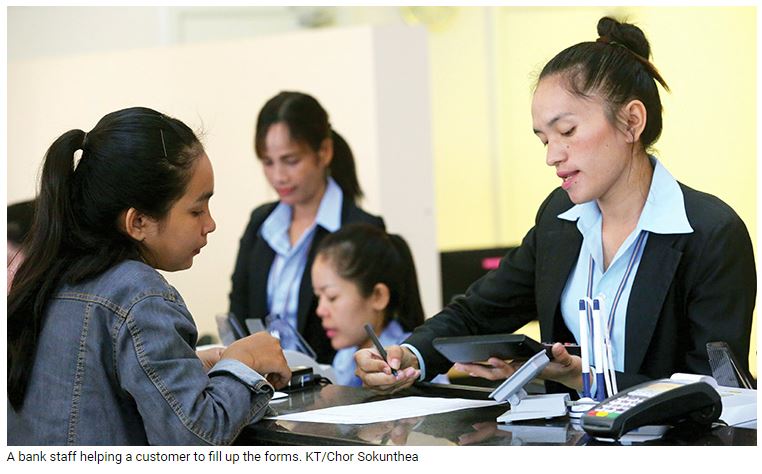Cambodia: Riel-based deposits and lending help NBC’s de-dollarisation efforts
The banking system has played a crucial role in supporting Cambodia’s recovery from the economic downturn in the wake of Covid-19 with National Bank of Cambodia (NBC) pursuing an accommodative and prudent monetary policy to meet the needs of the economy.
NBC has also been making serious efforts over the past several years to bring down the level of dollarisation in the economy by promoting the use of local currency riel (KHR).
According to the Financial Stability Review 2021 of the central bank, despite a series of steps, the level of dollarisation in the country still ruled over 80 percent. This high level of dollarisation limits the central bank’s role in influencing money supply and interest rates in the country, the report said.
The steps taken by NBC to de-dollarise the economy included regulations that aimed to boost loans in KHR. The central bank is of the view that a more riel-based economy will allow NBC to effectively implement the monetary policy in response to economic shocks.
While the commercial banks’ local currency lending stayed above NBC’s required threshold of 10 percent, most lending still continued to be in US dollars. A currency-wise breakdown of gross loans indicated that almost 88.6 percent of overall lending in 2021 was in USD, with the share of KHR loans standing at around 11.4 percent.
This shift towards using riel as the lending currency has been duly supported by NBC in terms of riel liquidity provision through its Liquidity-Providing Collateralized Operations (LPCO) since 2016.
Similarly, the bulk of the deposits with banks also remained in USD, accounting for 91.4 percent of total deposits in 2021. The share of riel deposits, however, rose from 6.1 percent in 2018 to around nine percent in 2021.
NBC’s policy requiring banks to lend at least 10 percent of their credit in KHR has encouraged banks to raise more local currency deposits. However, the size of local currency loans of KHR 18.3 trillion still remained higher than the local currency deposits of KHR 13.7 trillion the banks managed to collect in 2021, necessitating continued injection of riel liquidity by NBC through its LPCO arrangement, the report said.
But compared to the unbanked population of the country that uses the local currency riel for almost all transactions, it was those having the advantage of a banking system that continue to root for dollar transactions.
This is more due to the recognition of the US dollar as a stable international currency. According to various market sources and business leaders, the dual currency economy, in fact, has helped Cambodia to attract a large volume of foreign investment.
Vichet Lor, Phnom Penh President of Global Real Estate Association (GRA), told Khmer Times that the dual currency economy has contributed to the stability of the Cambodian riel in recent times
when almost all other Asian currencies dropped in value compared to the US dollar.
“We have seen that the Thai baht, the Malaysian ringgit and the Vietnamese dong are all going down against the dollar in the wake of the pandemic. The stability of the riel is believed to have been contributed by the dual currency economy,” he said.
“Foreign investors always evaluate the currency risk before making a decision. Lack of restrictions in currency movement – no outbound or inbound restrictions – also helped,” Lor said.
Ben Li, Founder and Chairman of Urban Village and Factory Phnom Penh, concurred with Lor saying recently that Cambodia having a dual currency economy with the US dollar as one of the currencies is a major attraction for foreign investors and the real estate market is a major beneficiary of this policy.
According to NBC’s ‘Macroeconomic and Banking Sector Development in 2022 and Outlook for 2023,’ report, stabilising the exchange rate is an important factor to maintain price stability in the context of high dollarisation.
The report also forecast that inflation in Cambodia is projected to decelerate to 2.5 percent this year.
“It is worth noting that. The stability of the exchange rate, especially between the riel and the US dollar, will maintain the purchasing power of the people whose income is in riel and contribute to lowering the prices of imported goods,” the report said.
However, given the high dollarisation, the appreciation of the US dollar will also raise the prices of Cambodia’s exports, which is another potential challenge that Cambodia will have to face.
The policy of the government and NBC continues to be in the direction of de-dollarisation, and encouraging commercial banks to lend in local currency and accept deposits also in local currency has helped in bringing more and more in the banked section of the population to the riel world. The process, though slow, continues to make steady progress.
De-dollarisation also holds cultural and geo-political significance to many around the world, including in Cambodia, and the rate at which the process of removing the dollar from the economy reflects a trend of sidelining the dollar that is happening slowly in certain major economies such as China, and also western countries such as those of the EU.
Source: https://www.khmertimeskh.com/501263299/riel-based-deposits-and-lending-help-nbcs-de-dollarisation-efforts-2/


 Thailand
Thailand




